Key to US Pheidole
This worker key to the Species of Pheidole (majors and minors) of the United States is based on: Gregg, R. E. 1958. Key to the species of Pheidole (Hymenoptera: Formicidae) in the United States. J. N. Y. Entomol. Soc. 66: 7-48 (page 26, soldier, worker, queen, male described)
This key is dated but can be useful to identify many Pheidole species in the United States.
You may also be interested in
1
- Antennal club composed of four segments (Subgenus Ceratopheidole) . . . . . 2
- Antennal club composed of three segments . . . . . 3
2
return to couplet #1
- Eyes of the minor with 10-12 facets in the greatest diameter; head subquadrate; dorsum of head, thorax, pedicel, and gaster somewhat shining; color reddish brown . . . . . Pheidole grundmanni
 Head of Pheidole grundmanni minor |
 Profile of Pheidole grundmanni minor |
- Eyes of the minor with 8-10 facets in the greatest diameter; head longer than broad; dorsum of body subopaque; color black . . . . . Pheidole clydei
 Head of Pheidole clydei minor |
 Profile of Pheidole clydei minor |
 Head of Pheidole clydei major |
 Profile of Pheidole clydei major |
3
return to couplet #1
- Gaster truncate or subtruncate at the base; species small to moderately large in size, usually dimorphic though occasionally polymorphic (Subgenus Pheidole) . . . . . 4
- Gaster not truncate at the base; giant species, polymorphic; epinotal spines unusually long and sharp (Subgenus Macropheidole) . . . . . Pheidole rhea
 Head of Pheidole rhea minor |
 Profile of Pheidole rhea minor |
 Head of Pheidole rhea major |
 Profile of Pheidole rhea major |
4
return to couplet #3
- Head of major cylindrical in cross-section and obliquely truncate in front, the truncation involving the clypeus, frontal area, and mandibles . . . . . Pheidole lamia
 Head of Pheidole lamia minor |
 Profile of Pheidole lamia minor |
 Head of Pheidole lamia major |
 Profile of Pheidole lamia major |
- Head of major not cylindrical in cross-section and not truncate . . . . . 5
5
return to couplet #4
- Scapes of major reaching or surpassing the occipital angles . . . . . 6
- Scapes of major not reaching the occipital angles . . . . . 7
6
return to couplet #5
- Upper surface of the head of the major densely granulo-rugose and dull; epinotal spines slender and directed upward . . . . . Pheidole vistana
 Head of Pheidole vistana minor |
 Profile of Pheidole vistana minor |
 Head of Pheidole vistana major |
 Profile of Pheidole vistana major |
- Upper surface of the head of the major with prominent longitudinal rugae, the interrugal spaces not granulose or at most very feebly granulose with the surface shining; epinotal spines thick at the base and directed posteriorly . . . . . Pheidole desertorum
 Head of Pheidole desertorum minor |
 Profile of Pheidole desertorum minor |
 Head of Pheidole desertorum major |
 Profile of Pheidole desertorum major |
7
return to couplet #5
- Antennal scape of the major abruptly bent at the base so that the scape turns toward the midline of the head in passing to the antennal socket, the basal portion of the scape flattened, and as broad or broader than the distal portion . . . . . 8
- Antennal scape of the major not abruptly bent at the base, not flattened or only slightly so, and the base never as broad as the distal portion of the scape . . . . . 17
8
return to couplet #7
- Antennal scape of the major reaching three-fourths or more of the distance between its insertion and the occipital angle . . . . . 9
- Antennal scape of the major reaching two-thirds or less of the distance between its insertion and the occipital angle . . . . . 14
9
return to couplet #8
- The entire dorsal surface of the head of the major covered with reticulo-rugose sculpture, the interrugal spaces granulose . . . . . 10
- The reticulo-rugose sculpture of the head of the major largely confined to the anterior half, the occipital lobes punctate or feebly granulose, the surface moderately to strongly shining at least on the posterior half of the head . . . . . 12
10
return to couplet #9
- Head of minor densely sculptured and completely opaque; postpetiole transversely oval and twice as wide as the node of the petiole . . . . . Pheidole texana
 Head of Pheidole texana minor |
 Profile of Pheidole texana minor |
 Head of Pheidole texana major |
 Profile of Pheidole texana major |
- Head of the minor in part, especially the frons, strongly shining and smooth, the rest punctate; postpetiole globular and less than twice as wide as the node of the petiole . . . . . 11
11
return to couplet #10
- Pronotal rugae of the major coarse, transverse, and with interrugal spaces notably shining; petiolar notch broad and shallow; gastric hairs long, nearly of equal length, coarse, blunt at the tips, and widely spaced . . . . . Pheidole sciara
 Head of Pheidole sciara minor |
 Profile of Pheidole sciara minor |
 Head of Pheidole sciara major |
 Profile of Pheidole sciara major |
- Pronotal rugae of the major weak and somewhat reticulate, with interrugal spaces granular, subopaque; petiolar notch feeble; gastric hairs short, uneven in length, fine, pointed at the tips, and more numerous . . . . . Pheidole cockerelli
 Head of Pheidole cockerelli minor |
 Profile of Pheidole cockerelli minor |
 Head of Pheidole cockerelli major |
 Profile of Pheidole cockerelli major |
12
return to couplet #9
- Head of minor densely punctate, opaque; erect hairs on the gaster of the major sparse and widely spaced . . . . . Pheidole vallicola
 Head of Pheidole vallicola minor |
 Profile of Pheidole vallicola minor |
 Head of Pheidole vallicola major |
 Profile of Pheidole vallicola major |
- Head of the minor smooth and shining; erect hairs on the gaster of the major numerous, long, and closely spaced . . . . . 13
13
return to couplet #12
- Head of major measuring 1.4 mm. x 1.3 mm.; female 7 mm. in length . . . . . Pheidole hyatti
 Head of Pheidole hyatti minor |
 Profile of Pheidole hyatti minor |
 Head of Pheidole hyatti major |
 Profile of Pheidole hyatti major |
- Head of major measuring 1.2 mm. x 1.1 mm.; female 5 mm. in length . . . . . Pheidole hyatti solitanea (=Pheidole hyatti)
14
return to couplet #8
- Occipital lobes of the major striato-granulose and scarcely shining . . . . . Pheidole obtusospinosa
 Head of Pheidole obtusospinosa minor |
 Profile of Pheidole obtusospinosa minor |
 Head of Pheidole obtusospinosa major |
 Profile of Pheidole obtusospinosa major |
(The strongly polymorphic worker caste of subdentata is a source of considerable confusion. The larger medias run through the key to hyatti or cockerelli, from which they would differ in having more rugose occipital lobes. The smaller medias approach the condition found in the major of desertorum, but have shorter and more numerous erect hairs on the thorax and gaster. For recent changes in the nomenclature of this and related species, see discussion at the end of this paper.)
- Occipital lobes of the major strongly shining and bearing piligerous punctures only . . . . . 15
15
return to couplet #14
- The flattened basal portion of the seape of the major notably broader than the distal portion . . . . . Pheidole porcula
 Head of Pheidole porcula minor |
 Profile of Pheidole porcula minor |
 Head of Pheidole porcula major |
 Profile of Pheidole porcula major |
- The flattened basal portion of the scape of the major no wider than its distal portion . . . . . 16
16
return to couplet #15
- Erect gastric hairs, when present, much longer and coarser than the fine appressed pubescence . . . . . Pheidole crassicornis
 Head of Pheidole crassicornis minor |
 Profile of Pheidole crassicornis minor |
 Head of Pheidole crassicornis major |
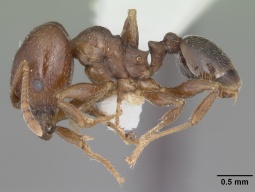 Profile of Pheidole crassicornis major |
- Erect gastric hairs very numerous, rather short and so fine that they merge with the pubescence, most of which is semi-erect . . . . . Pheidole tetra
 Head of Pheidole tetra minor |
 Profile of Pheidole tetra minor |
 Head of Pheidole tetra major |
 Profile of Pheidole tetra major |
17
return to couplet #7
- The tops of the occipital lobes of the major, and usually their front faces as well, covered with sculpture, the surface opaque or feebly shining . . . . . 18
- The tops of the occipital lobes of the major, and usually their front faces also, free from sculpture except for piligerous punctures, the surface in most cases strongly shining . . . . . 35
18
return to couplet #17
- Anterior border of the clypeus of the major with a deep semicircular emargination which extends inward almost to the level of the frontal lobes . . . . . Pheidole tepicana
 Head of Pheidole tepicana minor |
 Profile of Pheidole tepicana minor |
 Head of Pheidole tepicana major |
 Profile of Pheidole tepicana major |
- Anterior border of the elypeus of the major entire, or if impressed, the emargination is shallow and not semicircular . . . . . 19
19
return to couplet #18
- Humeral angles of the pronotum of the major weakly developed and not forming lateral bosses . . . . . 20
- Humeral angles of the pronotum of the major strongly developed and forming distinct, epaulet-like lateral bosses . . . . . 23
20
return to couplet #19
- Occipital lobes of the major with deep, broad, piligerous foveolae . . . . . Pheidole littoralis
 Head of Pheidole littoralis minor |
 Profile of Pheidole littoralis minor |
 Head of Pheidole littoralis major |
 Profile of Pheidole littoralis major |
- Occipital lobes of the major with distinct, transverse rugae . . . . . 21
21
return to couplet #20
- Head and thorax of minor punctate, opaque; hairs on the promesonotum of the major and especially the minor strongly clavate . . . . . Pheidole soritis
 Head of Pheidole soritis minor |
 Profile of Pheidole soritis minor |
 Head of Pheidole soritis major |
 Profile of Pheidole soritis major |
- Head and thorax of minor, at least in part, strongly shining; hairs not clavate . . . . . 22
22
return to couplet #21
- Entire head and promesonotum of minor smooth and strongly shining; transverse pronotal rugae of the major weak . . . . . Pheidole soritis
- Head of the minor with the frons striato-punctate and the occipital border punctate; pronotal rugae of the major prominent . . . . . Pheidole soritis
23
return to couplet #19
- Postpetiole of the major lenticular in shape, the lateral connules well-developed . . . . . 24
- Postpetiole of the major trapezoidal, the lateral connules absent or poorly developed . . . . . 31
24
return to couplet #23
- Head of the major 0.85 mm. in length, or less . . . . . 25
- Head of the major 1.4 mm. in length, or more . . . . . 26
25
return to couplet #24
- Occipital sculpture of the major reticulate, with no trace of transverse or longitudinal rugae . . . . . Pheidole dentigula
 Head of Pheidole dentigula minor |
 Profile of Pheidole dentigula minor |
 Head of Pheidole dentigula major |
 Profile of Pheidole dentigula major |
- Occipital sculpture of the major longitudinal, continuous with that of the rest of the head, and extending fully to the posterior occipital margin . . . . . Pheidole nuculiceps
 Head of Pheidole nuculiceps minor |
 Profile of Pheidole nuculiceps minor |
26
return to couplet #24
- Transverse rugae on the occiput of the major pronounced and usually extending onto the front face of the lobes . . . . . 27
- Transverse occipital rugae of the major much finer, resembling striations, and largely confined to the top of the occiput . . . . . 30
27
return to couplet #26
- Occipital rugae of the major straight or wavy, but not reticulate; lateral postpetiolar connules very prominent and sharp . . . . . 28
- Occipital rugae of the major notably reticulate and often coarse; lateral postpetiolar connules usually blunt . . . . . 29
28
return to couplet #27
- Cephalic rugae of the major wavy, with interrugal spaces granular producing a subopaque appearance; thorax except for the pronotum, granular and subopaque, dorsal rugae transverse . . . . . Pheidole senex
 Head of Pheidole senex minor |
 Profile of Pheidole senex minor |
 Head of Pheidole senex major |
 Profile of Pheidole senex major |
- Cephalic rugae of the major straight, with interrugal granules very fine or absent producing a shining surface; thorax almost completely smooth and shining . . . . . Pheidole creightoni
 Head of Pheidole creightoni minor |
 Profile of Pheidole creightoni minor |
 Head of Pheidole creightoni major |
 Profile of Pheidole creightoni major |
29
return to couplet #27
- Longitudinal rugae extend across the entire length of the head of the major; interrugal spaces finely punctured, opaque . . . . . Pheidole pilifera
 Head of Pheidole pilifera minor |
 Profile of Pheidole pilifera minor |
 Head of Pheidole pilifera major |
 Profile of Pheidole pilifera major |
- Longitudinal rugae on the head of the major interrupted at the vertex, which is distinctly shining and possesses only scattered hair punctures . . . . . Pheidole pilifera artemisia (=Pheidole pilifera)
30
return to couplet #26
- Front and vertex of the head of the major with coarse, widely spaced, piligerous foveolae, longitudinal rugae, and interrugal granulations; feebly shining . . . . . Pheidole pilifera coloradensis (=Pheidole pilifera)
- Front and vertex of the major with almost no sculpture other than small piligerous punctures, strongly shining; occipital rugae feeble . . . . . Pheidole pilifera pacifica (=Pheidole pilifera)
31
return to couplet #23
- Transverse occipital sculpture of the major in the form of fine rugules or striations . . . . . 32
- Occipital sculpture of the major in the form of more or less coarse rugae . . . . . 33
32
return to couplet #31
- Occipital striations very fine and turning forward onto the genae where they extend to the insertions of the mandibles . . . . . Pheidole micula
 Head of Pheidole micula minor |
 Profile of Pheidole micula minor |
 Head of Pheidole micula major |
 Profile of Pheidole micula major |
- Occipital striations heavier and more obvious, but not turning forward onto the genae . . . . . Pheidole rugulosa
 Head of Pheidole rugulosa minor |
 Profile of Pheidole rugulosa minor |
 Head of Pheidole rugulosa major |
 Profile of Pheidole rugulosa major |
33
return to couplet #31
- Sides of the epinotum on the major granulose, weakly shining or opaque . . . . . 34
 Head of Pheidole californica minor |
 Profile of Pheidole californica minor |
 Head of Pheidole californica major |
 Profile of Pheidole californica major |
- Sides of the epinotum on the major not granulose, very smooth and shining . . . . . Pheidole californica
34
return to couplet #33
- Occipital rugae of the major coarse and wavy, usually forming reticulations in the occipital sulcus . . . . . Pheidole californica
- Occipital rugae of the major finer, straight or nearly so, and usually not forming reticulations in the occipital sulcus . . . . . Pheidole californica
35
return to couplet #17
- Head of the major cordate, gradually but distinctly narrowed toward the mandibular insertions, broadest at the occipital lobes . . . . . Pheidole megacephala
 Head of Pheidole megacephala minor |
 Profile of Pheidole megacephala minor |
 Head of Pheidole megacephala major |
 Profile of Pheidole megacephala major |
- Head of the major not cordate, either quadrate or rectangular with sides parallel, or if slightly convergent, the broadest part of the head anterior to the occipital lobes . . . . . 36
36
return to couplet #35
- Head of the minor with a well-developed psammophore on the ventral surface, the latter flattened or slightly concave . . . . . Pheidole psammophila
 Head of Pheidole psammophila minor |
 Profile of Pheidole psammophila minor |
 Head of Pheidole psammophila major |
 Profile of Pheidole psammophila major |
- Head of the minor without a psammophore on the ventral surface, the latter convex . . . . . 37
37
return to couplet #36
- Head, thorax, and gaster of the minor, and often the major as well, with distinct violaceous or bluish reflections . . . . . 38
- Head, thorax, and gaster of the minor and major without violaceous reflections . . . . . 39
38
return to couplet #37
- Head of the minor in large part sculptured, only a narrow central strip smooth and shining . . . . . Pheidole metallescens
 Head of Pheidole metallescens minor |
 Profile of Pheidole metallescens minor |
 Head of Pheidole metallescens major |
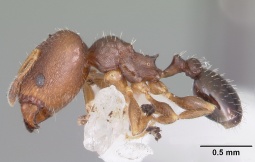 Profile of Pheidole metallescens major |
- Head of the minor largely smooth and shining . . . . . Pheidole metallescens
39
return to couplet #37
- Entire thorax of minor densely covered with granulose sculpture and completely opaque . . . . . 40
- At least a part of the promesonotum shining in the minor, or, if the entire thorax is opaque, the promesonotum is longitudinally striate and not densely granulose . . . . . 45
40
return to couplet #39
- Antennal scapes of the minor surpass the occipital angles by an amount greater than the length of the first funicular segment, sometimes twice as great . . . . . Pheidole sciophila
 Head of Pheidole sciophila minor |
 Profile of Pheidole sciophila minor |
 Head of Pheidole sciophila major |
 Profile of Pheidole sciophila major |
- Antennal scapes of the minor just reach the occipital angles or barely surpass them by an amount less than the length of the first funicular segment . . . . . 41
41
return to couplet #40
- Both major and minor with the entire dorsal surface of the first gastric segment finely and densely granulose and opaque . . . . . Pheidole anastasii
 Head of Pheidole anastasii minor |
 Profile of Pheidole anastasii minor |
 Head of Pheidole anastasii major |
 Profile of Pheidole anastasii major |
- Dorsum of the first gastric segment in both major and minor entirely, or at least largely, smooth and shining; sculpture when present confined to an area near the base of the gaster . . . . . 42
42
return to couplet #41
- Pronotum of the major strongly convex when seen from behind, the humeral angles not prominent and lying well below the level of the middle of the pronotum; head of the minor largely free from sculpture and strongly shining . . . . . Pheidole davisi
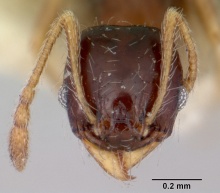 Head of Pheidole davisi minor |
 Profile of Pheidole davisi minor |
 Head of Pheidole davisi major |
 Profile of Pheidole davisi major |
- Pronotum of the major flat or feebly convex when seen from behind, the humeral angles sharp, prominent, and lying at or near the level of the middle of the pronotum; head of minor usually densely sculptured and completely opaque, but if not at least the sides of the head are sculptured and only the middle is shining . . . . . 43
43
return to couplet #42
- Postpetiole of the minor small and globular, not more than one-and-one-half times as wide as the petiole . . . . . Pheidole flavens
 Head of Pheidole flavens minor |
 Profile of Pheidole flavens minor |
 Head of Pheidole flavens major |
 Profile of Pheidole flavens major |
- Postpetiole of the minor not globular but pyriform, and twice as wide as the petiole . . . . . 44
44
return to couplet #43
- Occipital lobes of the major smooth and shining throughout; clypeus with several longitudinal rugae; hairs long, tapering, and pointed . . . . . Pheidole floridana
 Head of Pheidole floridana minor |
 Profile of Pheidole floridana minor |
 Head of Pheidole floridana major |
 Profile of Pheidole floridana major |
- Occipital lobes of the major reticulo-rugose and opaque, except for a narrow shining band along their posterior margins; clypeus without rugulae; hairs short and obtuse . . . . . Pheidole constipata
 Head of Pheidole constipata minor |
 Profile of Pheidole constipata minor |
 Head of Pheidole constipata major |
 Profile of Pheidole constipata major |
45
return to couplet #39
- Propodeum of the major angular at the junction of the basal and declivious faces, but the angles not produced into distinct teeth or spines . . . . . 46
- Propodeum of the major armed with distinct teeth or spines . . . . . 48
46
return to couplet #45
- Prothorax of the major with well-developed humeri; postpetiole with prominent lateral connules . . . . . Pheidole barbata
 Head of Pheidole barbata minor |
 Profile of Pheidole barbata minor |
 Head of Pheidole barbata major |
 Profile of Pheidole barbata major |
- Prothorax of the major without well-developed humeri; postpetiole without prominent lateral connules . . . . . 47
47
return to couplet #46
- Abdominal pilosity largely limited to coarse, erect hairs; length of the major 3.5-4 mm . . . . . Pheidole morrisii
 Head of Pheidole morrisii minor |
 Profile of Pheidole morrisii minor |
 Head of Pheidole morrisii major |
 Profile of Pheidole morrisii major |
- Abdominal pilosity with many fine, subappressed hairs in addition to the coarse, erect hairs; length of the major 4-5 mm . . . . . Pheidole morrisii
48
return to couplet #45
- Large species, the head of the major at least 2 mm. in length and usually more . . . . . 49
- Small species, the head of the major not exceeding 1.5 mm. in length and usually less . . . . . 54
49
return to couplet #48
- Pronotum of the major with transverse striae . . . . . 50
- Pronotum of the major without transverse striae . . . . . 52
50
return to couplet #49
- Head of the major with longitudinal rugae confined to the anterior half, posterior half without sculpture except for piligerous punctures . . . . . 51
- Head of the major with longitudinal rugae extending onto the anterior portions of the occipital lobes . . . . . Pheidole titanis
 Head of Pheidole titanis minor |
 Profile of Pheidole titanis minor |
 Head of Pheidole titanis major |
 Profile of Pheidole titanis major |
51
return to couplet #50
- Head of the major with a flattened, rugose area interposed between the frontal lobe and the eye, and furnished with large, interrugal foveolae; petiole with prominent lateral spiracles . . . . . Pheidole macclendoni
 Head of Pheidole macclendoni minor |
 Profile of Pheidole macclendoni minor |
 Head of Pheidole macclendoni major |
 Profile of Pheidole macclendoni major |
- Head of the major without a flattened, rugose area between the frontal lobe and the eye; petiole unarmed . . . . . Pheidole virago
 Head of Pheidole virago major |
 Profile of Pheidole virago major |
52
return to couplet #49
- Postpetiole of the major, seen from above, very strongly transverse and notably constricted posteriorly, with prominent, sharply pointed lateral connules . . . . . Pheidole spadonia
 Head of Pheidole spadonia minor |
 Profile of Pheidole spadonia minor |
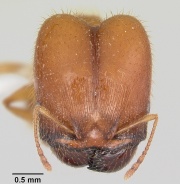 Head of Pheidole spadonia major |
 Profile of Pheidole spadonia major |
- Postpetiole of the major, seen from above, only moderately transverse and not greatly constricted posteriorly, with rather short and blunt lateral connules . . . . . 53
53
return to couplet #52
- Head of the major notably longer than broad (2.2 mm. x 1.6 mm.); the genae suddenly expanded just behind the insertions of the mandibles . . . . . Pheidole absurda
 Head of Pheidole absurda minor |
 Profile of Pheidole absurda minor |
 Head of Pheidole absurda major |
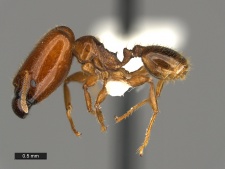 Profile of Pheidole absurda major |
- Head of the major very little broader than long (2.5 mm. x 2.4 mm.); the genae not expanded above the insertions of the mandibles . . . . . Pheidole militicida
 Head of Pheidole militicida minor |
 Profile of Pheidole militicida minor |
 Head of Pheidole militicida major |
 Profile of Pheidole militicida major |
54
return to couplet #48
- Sculpture on the head of the major extending to the vertex, only the occiput smooth and shining . . . . . Pheidole ceres
 Head of Pheidole ceres minor |
 Profile of Pheidole ceres minor |
 Head of Pheidole ceres major |
 Profile of Pheidole ceres major |
- Sculpture on the head of the major largely confined to the anterior half of the head, the posterior half smooth and shining . . . . . 55
55
return to couplet #54
- Mesonotum of the major depressed below the adjacent portion of the pronotum so that in profile it forms a distinct step or angular projection between the pronotum and the propodeum. . . . . Pheidole dentata
 Head of Pheidole dentata minor |
 Profile of Pheidole dentata minor |
 Head of Pheidole dentata major |
 Profile of Pheidole dentata major |
- Mesonotum of the major not depressed below the adjacent portion of the pronotum, in profile the two forming an evenly curved outline which usually descends abruptly at the mesoepinotal suture . . . . . 56
56
return to couplet #55
- Eyes of the major with 60 facets, or more . . . . . 57
- Eyes of the major with 40 facets, or less . . . . . 60
57
return to couplet #56
- Head of the major with a flattened area extending posteriorly from the antennal fossa toward the occipital lobe; occipital lobes compressed dorso-ventrally, the posterior one-third of the head, seen in profile, with dorsal and ventral surfaces converging notably toward the crest of the lobe . . . . . 58
- Head of the major without a flattened area extending posteriorly from the antennal fossa; the occipital lobes not compressed dorso-ventrally, thick and evenly rounded when seen in profile, and not sharply set off from the anterior part of the head . . . . . Pheidole yaqui
 Head of Pheidole yaqui minor |
 Profile of Pheidole yaqui minor |
 Head of Pheidole yaqui major |
 Profile of Pheidole yaqui major |
58
return to couplet #57
- Major with the dorsum of the pronotum covered with numerous, coarse, reticulate rugae in addition to the more nearly parallel transverse rugae on the anterior face and on the neck; interrugal surfaces heavily coriaceous, opaque or nearly so . . . . . Pheidole xerophila
 Head of Pheidole xerophila minor |
 Profile of Pheidole xerophila minor |
 Head of Pheidole xerophila major |
 Profile of Pheidole xerophila major |
- Major with the dorsum of the pronotum bearing few or no rugae, the rugae mainly restricted to the anterior face and neck of the pronotum, and not noticeably reticulate; interrugal surfaces smooth to slightly coriaceous, moderately to strongly shining . . . . . 59
59
return to couplet #58
- Postpetiole of the major trapezoidal, the lateral connules short and obtuse; color golden yellow to dull yellow, head of the minor sometimes infuscated . . . . . Pheidole gilvescens
 Head of Pheidole gilvescens minor |
 Profile of Pheidole gilvescens minor |
 Head of Pheidole gilvescens major |
 Profile of Pheidole gilvescens major |
- Postpetiole of the major strongly transverse, with long lateral connules; color ferruginous red to blackish red, the minor piceous brown . . . . . Pheidole xerophila
 Head of Pheidole xerophila minor |
 Profile of Pheidole xerophila minor |
 Head of Pheidole xerophila major |
 Profile of Pheidole xerophila major |
60
return to couplet #56
- Vertex and occiput of the minor with small, close-set punctures which give the surface a noticeably duller appearance on those parts than elsewhere on the head . . . . . 61
- Vertex and occiput of the minor strongly shining or only slightly less shining than the rest of the head, the punctures widely scattered over the whole head . . . . . 62
61
return to couplet #60
- Basal face of the epinotum of the major sculptured and opaque . . . . . Pheidole casta
 Head of Pheidole casta minor |
 Profile of Pheidole casta minor |
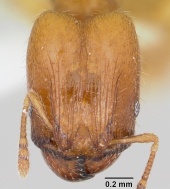 Head of Pheidole casta major |
 Profile of Pheidole casta major |
- Basal face of the epinotum of the major in large part shining, its sculpture restricted to punctures near the mesoepinotal suture . . . . . Pheidole cerebrosior
 Head of Pheidole cerebrosior minor |
 Profile of Pheidole cerebrosior minor |
 Head of Pheidole cerebrosior major |
 Profile of Pheidole cerebrosior major |
62
return to couplet #60
- Basal face of the epinotum of the major free from sculpture and strongly shining . . . . . Pheidole humeralis
 Head of Pheidole humeralis minor |
 Profile of Pheidole humeralis minor |
 Head of Pheidole humeralis major |
 Profile of Pheidole humeralis major |
- Basal face of the epinotum of the major distinctly sculptured, feebly shining and opaque . . . . . 63
63
return to couplet #62
- Sides of the epinotum of the minor largely free from sculpture and strongly shining . . . . . Pheidole tysoni
 Head of Pheidole tysoni minor |
 Profile of Pheidole tysoni minor |
 Head of Pheidole tysoni major |
 Profile of Pheidole tysoni major |
- Sides of the epinotum of the minor densely punctured, feebly shining and opaque . . . . . 64
64
return to couplet #63
- Lateral connules on the postpetiole of the major prominent and sharp pointed . . . . . Pheidole pinealis
 Head of Pheidole pinealis minor |
 Profile of Pheidole pinealis minor |
 Head of Pheidole pinealis major |
 Profile of Pheidole pinealis major |
- Lateral connules on the postpetiole of the major blunt and not prominent . . . . . 65
65
return to couplet #64
- Erect hairs on the thorax of the minor short, sparse, and strongly clavate . . . . . Pheidole marcidula
 Head of Pheidole marcidula minor |
 Profile of Pheidole marcidula minor |
 Head of Pheidole marcidula major |
 Profile of Pheidole marcidula major |
- Erect hairs on the thorax of the minor long, abundant and, although often blunt at the tips, not clavate . . . . . 66
66
return to couplet #65
- Anterior clypeal margin of the major sinuate; pronotum smooth and shining . . . . . Pheidole paiute
 Head of Pheidole paiute minor |
 Profile of Pheidole paiute minor |
 Head of Pheidole paiute major |
 Profile of Pheidole paiute major |
- Anterior clypeal margin of the major bluntly bidentate; pronotum punctate and usually with transverse rugae or striae . . . . . 67
67
return to couplet #66
- Basal face of the epinotum in the major largely covered with transverse striae, and with punctures confined. to the region of the mesoepinotal suture; pronotal rugae coarse and prominent . . . . . Pheidole bicarinata
 Head of Pheidole bicarinata minor |
 Profile of Pheidole bicarinata minor |
 Head of Pheidole bicarinata major |
 Profile of Pheidole bicarinata major |
- Basal face of the epinotum in the major largely punctate, transverse striae, when present, restricted to the area between the bases of the epinotal spines; pronotal rugae feeble . . . . . 68
68
return to couplet #67
- Epinotum of the minor armed with thick, short spines . . . . . Pheidole bicarinata
- Epinotum of the minor armed with angular teeth which are broad at the base and do not resemble spines . . . . . Pheidole bicarinata